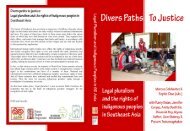The Upper Caura, Venezuela - Forest Peoples Programme
The Upper Caura, Venezuela - Forest Peoples Programme
The Upper Caura, Venezuela - Forest Peoples Programme
Create successful ePaper yourself
Turn your PDF publications into a flip-book with our unique Google optimized e-Paper software.
Protecting and encouraging customary use of biological resources: <strong>The</strong> <strong>Upper</strong> <strong>Caura</strong>, <strong>Venezuela</strong>_________________________________________________________________________________________Settlement patterns<strong>The</strong> most important way that community pressure on resources is regulated and controlledis during the process of selecting sites for new settlements. As noted, village sites are oftenchosen by shamans who gain knowledge about the spirits through dreaming and conversingwith their spirit allies. <strong>The</strong>y take into account factors such as soil quality, access to gooddrinking water from creeks, vicinity of neighbouring settlements and the availability ofgame. 23New villages are only established after extensive consultations and often involveneighbouring settlements in very long drawn out discussions and negotiations which maytake place over several months or even years. During these processes, full scope is given toexamining the relations between the communities, establishing whether other communitieshave proprietary rights in the proposed areas and assessing the suitability of the area forlivelihoods. Particularly for the Ye’kwana, for whom the investment in establishing a newvillage is very significant, such decisions are not undertaken lightly as the ideal is that a newvillage will endure for a very long time.<strong>The</strong> consequence of this thoughtful and highly consultative process of decision-making isthat Ye’kwana villages are very widely spread out across the whole river basin, therebyensuring that pressure on natural resources is kept to a minimum.Customarily the Sanema move their more simply constructed villages with much greaterfrequency than the Ye’kwana. Rather than carrying out hunting expeditions in distanthunting zones using canoes to reach them, the Sanema rely on the resources in theimmediate vicinity of their villages. As resources become locally depleted, food-sharingnorms ensure that the whole community quickly and simultaneously sense the diminution.Dissatisfaction with the locale grows and the community becomes increasingly disposed tosuggestions of relocation. By frequently moving their villages, their load on theenvironment is attenuated.23 Cf. Marcus Colchester, 1997, Conservation Politics: the <strong>Upper</strong> Orinoco-Casiquiare Biosphere Reserve. In:Andrew Gray, Alejandro Parellada and Helen Newing (eds.), From Principles to Practice: Indigenous <strong>Peoples</strong>and Biodiversity Conservation in Latin America, <strong>Forest</strong> <strong>Peoples</strong> <strong>Programme</strong> and International Work Groupfor Indigenous Affairs, Copenhagen: 131-154.27
















